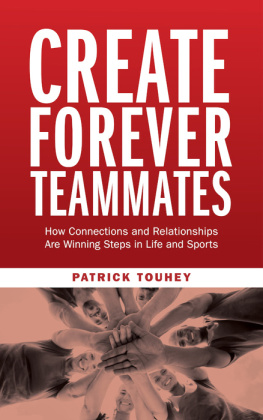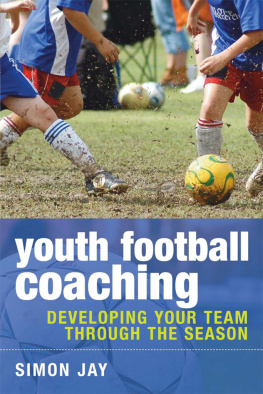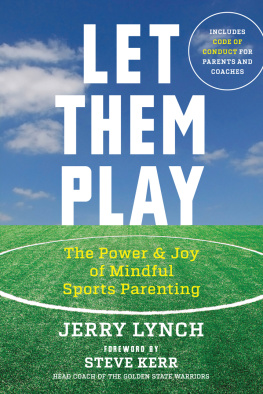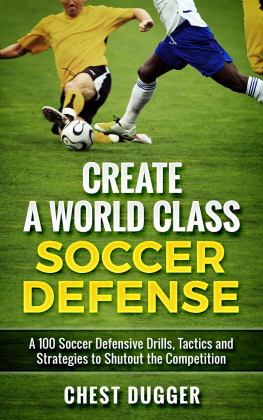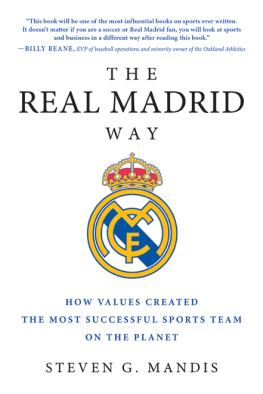
Copyright 2021 Patrick Touhey
All rights reserved. No part of this publication may be reproduced, distributed, or transmitted in any form or by any means, including photocopying, recording, or other electronic or mechanical methods, without the prior written permission of the publisher, except in the case of brief quotations embodied in critical reviews and certain other noncommercial uses permitted by copyright law. For permission requests, write to the publisher, addressed Attention: Permissions Coordinator, at the address below.

574-360-9188.
eliteperformancetoo-e.com
ISBN: 978-1-7379762-0-2 (print)
ISBN: 978-1-7379762-1-9 (ebook)
Ordering Information:
Special discounts are available on quantity purchases by corporations, associations, and others. For details, contact

FOREWORD
CULTURE TRUMPS STRATEGY
In 2011, I became the athletic director at Denison University, my alma mater, and was tasked to lead a strong and flourishing program. Id spent many years of my life preparing for this new opportunity, and was confident that my experience as a coach and teacher at two very strong liberal arts institutions would be enough to overcome any challenges I might face.
Early on, it became apparent that some of our student-athletes werent enjoying their experience. At the time, we were working hard to develop our core competencies and define success despite being in an era where the external audience only saw our wins and losses. Our goal was to create an environment where our student athletes could grow academically, athletically, and socially. While that might sound simple, its actually very complex work.
Winning and success are important without a doubt, but anyone who has competed in college athletics knows that it is the relationships you remember most. This is why it was imperative for us to create a space that was conducive for relationship, individual, and team development so that our students could achieve what we perceive to be the ultimate success in college athletics.
With some of the issues that were popping up at the university, I decided we could use an outside resource to help us accomplish our goals. Once I had the opportunity to meet Kevin Touhey and read his books, I hired him to help me lead the division. I wanted him to take a deep dive into our programs and aid those teams who might need more hands-on work building team culture.
For many years, Kevin was a big part of the Denison family and remains so to this day despite his untimely loss to cancer. While this loss was a heavy one to bear, little did I know that Kevin was helping his brother Patrick to develop his intellectual material in the cultural development space.
After several years of getting to know Patrick, I hired him to continue the work we started with Kevin to identify teams within our programs that had existing challenges developing team culture. Patrick traveled to the small village of Granville on glorious fall days, bitter-cold wintery days, and in the Ohio chilly days of spring. While not everyone loves self-reflection or develops habits of self-awareness in an effort to grow, those who lead understand the importance of this work.
Patricks book is a testimony of how walking into the space of vulnerability, we learn the skills necessary for self-growth throughout ones lifetime. Patrick uses the platform of sport to help facilitate the growth and development of life skills. His writing is real, poignant, vulnerable and inspired.
Patrick is the real deal and utilizes his lifes experiences to develop workshops to help others grow, individually and collectively.
I applaud his writing and plan to continue to team up with Patrick as my leadership work unfolds.
But above all else, Id like to thank you, Patrick, for your vulnerability, honesty, and integrity in building your leadership-development workshops. And to all the readers, I hope you enjoy this book, get real, and continue to embrace a growth mindset for life!
Nan Carney-DeBord
Associate Vice President of Athletics and Recreation
Denison University
CONTENT WARNING
This book contains language pertaining to topics such as alcohol, drugs, suicide, cancer, suicidal ideation, anxiety, death, depression, addiction, disordered eating, homophobia, abortion, self-harm, and racism.
DISCLAIMER
This book is a work of creative nonfiction. I have reconstructed and portrayed the characters and events to the best of my memory and ability. While all the stories and events in this book are true, some names and identifying details have been changed to protect the privacy of the people involved. Also, because no conversations can be remembered word for word verbatim, the basis of the dialogues in all instances are accurate and have been retold to capture and express the concepts, feelings, and emotions.
CHAPTER ONE
I remember what it took to get a game of basketball going when I was a kid.
First, I would call George to start the chain reaction. George would call Jerry, Jerry would call Ethan, Ethan would call Tim, and so on, until a herd of us gathered through telephone lines.
Whenever I told my parents what I was going to do, their reactions werent full of fear or anxiety about potential dangers or injuries. Instead, they would offer a simple, Have fun! as I walked out the door.
And with that first gust of fresh air, excitement began coursing through my veins. I was on the precipice of independence, imagination, and joy, impatient to play my favorite sport with people I loved.
Most of the time walking wasnt quick enough, so Id run around the corner and sprint down a few streets, collecting friends as I went and only slowing down when we reached our destination at the corner of Penn Avenue and Sixth Street. All together, we headed toward the court side by side, jabbering about who was going to be on each team and who the best players were.
It all came with a feeling of endless possibilities, the excitement bursting from the cacophony of our voices. There was chaos as we constantly cut off one another, switching subjects that ranged from what kind of mischief we were going to get into later that day to our dreams of going pro until eventually we reached the court and pretended we actually were.
These pick-up games that were formed became the vehicle through which we found ourselves. We had to choose teams, be leaders and listeners, practice decision-making, and handle the disappointment when you were the last one chosen. And when the ball was picked up and we started to play, there was strategic thinking, competition, and more dreaming as we imitated the greats like Jerry West, Clyde Frazier, and Bill Russell.
We made all of this happen without ever getting our parents involved. Maybe this is something you can relate to, or maybe youre just someone who recognizes we have a big problem with the way sports are played today.
Due to the lack of integrating spirit, fun, and excitement, the overall experience of playing sports is similar to having a job for a large corporation. The student-athletes take orders from the big man, play specialized roles, and create a product thats called winning. Everything is run by adults, and instead of kids being forced to figure it out themselves, coaches organize drills and teach techniques while parents watch their child intently and yell out corrections from the sideline. In every facet, adults are interjected into the experience until it becomes about
Next page
